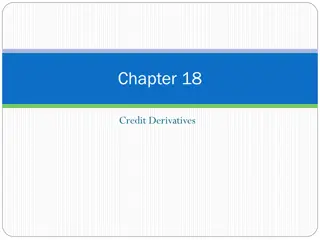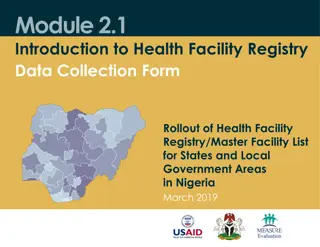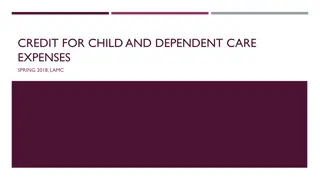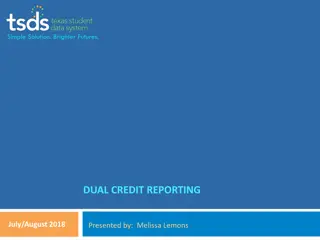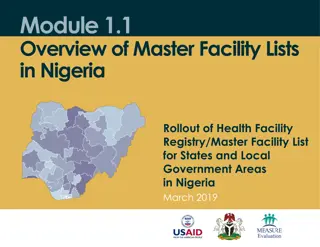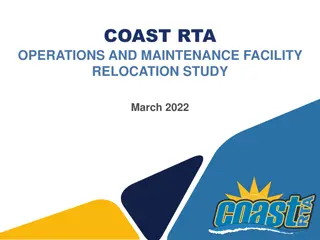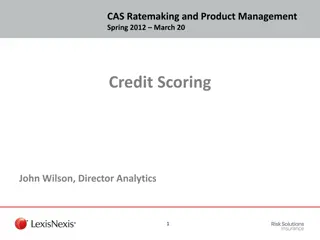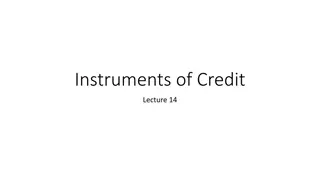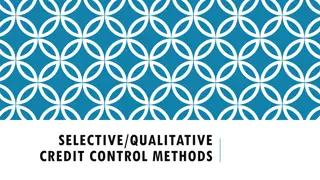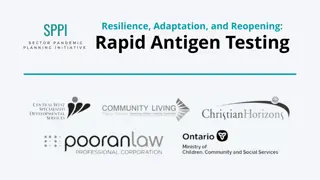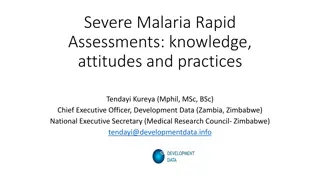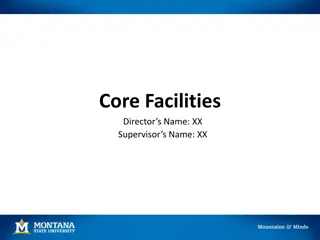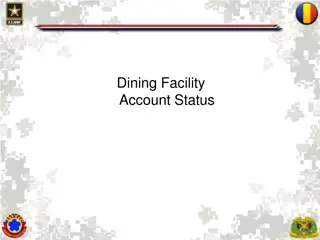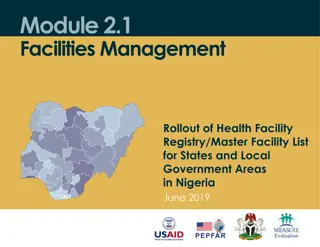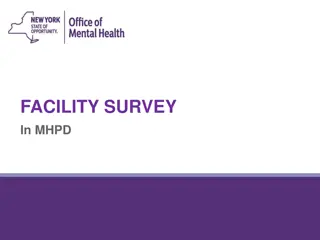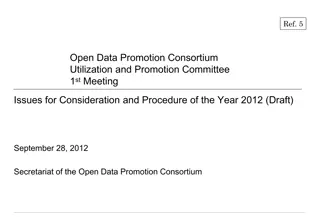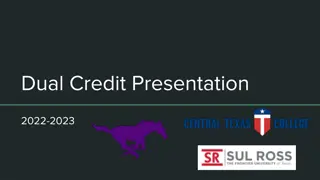Update on South Sudan's Rapid Credit Facility and Rationale for Utilization
South Sudan's progress was disrupted by the COVID-19 pandemic and oil price shock, leading to economic contraction. To address urgent fiscal deficits, the country secured IMF assistance through the Rapid Credit Facility (RCF). The RCF funds were utilized to clear salary arrears and support economic recovery measures, with detailed financial transactions provided.
Download Presentation

Please find below an Image/Link to download the presentation.
The content on the website is provided AS IS for your information and personal use only. It may not be sold, licensed, or shared on other websites without obtaining consent from the author. Download presentation by click this link. If you encounter any issues during the download, it is possible that the publisher has removed the file from their server.
E N D
Presentation Transcript
Update on the Rapid Credit Facility (RCF) Preliminary Reports. Presented by: Ocum Genes Karlo Undersecretary for Planning MoFP. Presented to: Oversight Committee 25thMarch 2021
2 Structure of the presentation Background Rationale RCF Utilization Next Steps 29/09/2024
3 Background Prior to the COVID-19 pandemic, South Sudan had achieved significant progress due to improved political stability from the R-ARCSS and increase in global oil prices. Economic growth improved, inflation declined, and the exchange rate began to stabilize. However, due to the severe economic disruption from the pandemic and oil price shock, fiscal and external balances deteriorated, and economic growth contracted. Our economy is projected to contract 3.6 percent in FY20/21,about 10 percentage points below the pre-pandemic baseline. The government reacted quickly by initiating public financial management reforms, to streamline public expenditure and ensure that resources are utilized for the COVID19 response A governance structure for PFM-Reforms was established, comprised of the PFM-Oversight Committee, PFM-Technical Committee and PFM-Secretariat. Under the guidance from the PFM-Oversight Committee, the government applied for emergency financing from the International Monetary Fund (IMF) to support the national response to COVID 19 In November 2020, the International Monetary Fund (IMF) approved US$52.3 million to South Sudan under the Rapid Credit Facility (RCF). This is the first IMF supported financial assistance provided to South Sudan since it joined the Fund in 2012. 29/09/2024
4 Rationale. The purpose of the RCF is to help address urgent fiscal deficit of five (5) months salary arrears, The insufficient oil revenues created the fiscal deficit resulting into accumulated five (5) months salary arrears 29/09/2024
5 RCF Utilization The GRSS decided from among other priorities that the RCF would be used to clear 5 months (June October 2020) of salary arrears at the national level and transfers to states. The Ministry of Finance and Planning initiated the opening of a dedicated bank account for the RCF funds and created a special fund code in IFMIS to track expense against RCF funds and to report. The NCBA BANK KENYA PLC, Nairobi Kenya, was the correspondent Bank in which the USD equivalent from IMF would be credited. On October 4th, 2020, a separate account was opened for the Ministry of Finance and Planning in the Bank of South Sudan dedicated for the RCF funds. Upon receipt of this payment from IMF, the Bank of South Sudan will transfer the USD equivalent of XDR 36,900,000 to the Ministry of Finance Account (RCF Account) at the Bank of South Sudan (BoSS). On 11th November 2020, the amount of USD 52,328,252.72 was disbursed by IMF in Washington. It was credited to BoSS Account in Nairobi on 13th November 2020. The same amount was then credited to the Ministry of Finance RCF (USD Acct) at the Bank of South Sudan on the 15th November 2020.
6 Amount converted from USD into SSP S/No 1. 2. Date Amount in USD 40,325,000 5,300,000 45,625,000 Rate 174.07430 174.47270 Amount (In SSP) 7,019,546,147.50 924,705,310.00 7,944,251,457.50 26th Nov 2020 13th Dec 2020 Total MoFP received Seven Billion Nine Hundred Million Forty-Four Million Two Hundred Fifty-One Thousand Four Hundred Fifty-Seven and 50/100 SSP from FX sale to BSS, which was deposited in the MoFP RCF (SSP Account) in BoSS. As a mechanism for good tracking procedures of the expenditures against RCF funds, MoFP created a separate Fund Code in the IFMIS dedicated for recording and tracking expenditures against the RCF funds in the system. Payment of salary arrears as a share of RCF S/No 1. Amount sold to BoSS to pay domestic salary arrears in SSP 2. Amount used to pay salary arrears to diplomats (USD) Total amount for paying salary arrears (SSP & USD) Item description Amount (in USD) 45,625,000.00 5,993,664.48 51,618,664.48 One month of salary arrears was paid to foreign missions (diplomats) The share of RCF used for payments of salary arrears to diplomats in USD is 12% Two months of salary arrears was paid for domestic government workers. The share of RCF used to pay salary arrears for domestic government workers in SSP is 88% A total of USD 51.6 million was utilized for paying salary arrears constituting 98.6% 29/09/2024
7 RCF Utilization cont d Summary of two months (June & July 2020) salary arrears (In Bns SSP) S/No Category Amount (In Bns SSP) As a % age 33.2% 32.4% 34.4% 100% 1. 2. 3. 4. Civil servants Organized Forces Transfers to States Total 2,511,375,854.00 2,450,071,305.00 2,598,160,545.98 7,559,607,704.98 Payment of salary Arrears by % 33% 34% Civilian Org Forces 33% States The total payments for two months amounted to about 7,560 billion SSP. Of this, about 4,961 billion SSP was used for paying central government employees, which constitutes about 65%. SSP 2,511 billion was used for paying Civil servants, which constitutes 33% . Approximately SSP 2,450 billion was used for paying Organized Forces, which constitutes about 32%. The remaining 2,598 billion SSP was used for paying transfers to States, which constitutes about 34%. 29/09/2024
RCF Utilization contd Distribution of RCF Proceeds by Sectors in the Civil Services 8 Summary distribution of RCF Funds by Sectors in the Civil Service (In Bns SSP) June - Exp July - Exp as % age Sector Accountability Sector Economic Function Education Sector Health Sector Infrastructure Sector Natural Resources Sector Public Admin Sector Rule of Law Sector Security Sector Humanitarian & Social Welfare 7,228 14,553 1,145,156 10,822 3,862 4,751 13,935 11,374 7,458 14,616 1,223,016 10,580 3,896 4,734 13,993 10,730 0.6% 1.2% 94.3% 0.9% 0.3% 0.4% 1.1% 0.9% 0.1% 0.3% 838 4,351 843 4,434 1,216,871 1,294,300 100.0% Distribution of RCF Funds by Sectors Amounts In Mn SSP 1,400,000 1,200,000 1,000,000 800,000 600,000 400,000 200,000 0 Sectors June - Exp July - Exp 29/09/2024
9 Summary distribution of RCF for Organized Forces Summary Distribution of RCF Proceeds to Organized Forces by Agency (In Bn SSP) Jun-2020 Actaul Expenditures Ministry of Interior HQs Fire Brigade Fire Brigade Police Nationality and Passport Prisons Tourism Tourism Wildlife Veterans Affairs Veterans Affairs Ministry of Defence Ministry of Defence Ministry of Defence General Inteligence Bureau Internal Security Bureau Customs Service(NRA) Grand Total 1,112,813 Jul-2020 Actual Expenditures Agency % 141 141 0.01% 1.36% 0.12% 10.62% 1.09% 1.42% 0.03% 0.01% 2.24% 13.77% 0.02% 50.51% 1.01% 7.95% 0.96% 6.64% 2.25% 100% 16,618 1,489 128,086 13,323 17,429 16,618 1,489 132,058 13,413 17,429 414 103 414 103 27,388 168,628 27,388 168,628 227 234 618,361 619,117 24,798 194,822 11,776 81,326 27,505 1,337,259 11,776 81,326 27,505 29/09/2024
10 Summary distribution of RCF for Organized forces Distribution of RCF Funds for Organized Forces 700,000 600,000 500,000 400,000 300,000 200,000 100,000 0 Jun-2020 Actaul Expenditures Jul-2020 Actual Expenditures % 29/09/2024
11 The number of employees that benefited from RCF Table 5: Central Government workforce that benefited from the RCF by Sectors % Sectors Categories of employees total workforce 0.2% Civil Servants 760 Accountability 2.3% Economic Civil Servants 10,772 2.0% Education Teachers and other personnel 9,443 1.2% Health Workers and other personnel 5,597 Health Infrastructure 0.3% 2.1% Civil Servants 1,437 Natural Resources Civil Servants 9,907 1.7% Public Administration Rule of Law Civil Servants Organized Forces and other personnel 7,971 61,991 13.2% 76.5% Organized Forces 358,171 Security 0.4% Civil Servants 1,981 Humanitarian 100% Total - 468,030 29/09/2024
12 The number of employees that benefited from RCF (cont.) The total workforce in the central government is 468,030. Of this, 358,171 are organized forces in the security sector which constitute 76% 61,991 are Organized Forces in the rule of law (mainly Police, Prisons and civil defense. This constitutes about 13% The remaining 47,868 are civilians from other sectors about 10% 29/09/2024
13 NEXT STEPS The government is currently negotiating a Staff Monitored Program (SMP) with the IMF . As part of the SMP, GRSS has applied for a second RCF The MoFP is working hard to ensure that GRSS fulfills its reporting requirements for the utilization of the first RCF. The Ministry have deployed teams to all 10 State capitals that will be joined by their counterparts from CSOs to receive and review accountability reports This is a condition for the second RCF. We expect the application for the second RCF to be presented for consideration of the IMF Board by end of March 2021 The amount expected under the second RCF is estimated at $172 million. 29/09/2024
14 Thank you 29/09/2024







